Cite this as: Dannell, G.B. 2018 The Uses of South Gaulish Terra Sigillata on the Roman Table. A study of nomenclature and vessel function, Internet Archaeology 50. https://doi.org/10.11141/ia.50.5
Terra sigillata (hereafter referred to as sigillata) from Italy and Southern Gaul was the standard tableware from the late first century BCE until the early second century CE in the west. This article discusses the types of vessels described by the potters who made them, the food and drink associated with the vessels, and the difficulties of identifying modern equivalents to those types in the standard type-series evolved by scholars in the nineteenth and twentieth centuries. Data from stamped vessels are then used to examine spatial and temporal variations. Ideal place settings are suggested, and avenues for future research.
The context for any attempt to understand how Roman tableware was used must be based upon its primary purpose, which was the containment and serving of food and drink. No amount of abstract categorisation can replace that as the primary approach to research, but data analysis can be used to test relationships and trends, as well as to identify regional preferences and divergences.
Sigillata is of particular interest, because it was made in many potteries across the Roman Empire. The Italian and Gaulish/Rhaetian industries were particularly active in the west (Ettlinger et al. 1990; Oswald and Pryce 1920). The standard modern nomenclature for this sigillata uses type-series established in the late nineteenth and early twentieth centuries by various scholars and the different vessel's shapes are generally known as 'forms', catalogued using the shortened name of their original cataloguer as a prefix to a numerical series. There are many shapes that have either not been found or recognised on export sites, and must be rarities (Genin 2007, plates 38-118). These shapes therefore, do not have form numbers as yet.
While the term sigillata was originally descriptive of those vessels impressed with a name-stamp, taken to be that of the maker, it is now generally applied to a whole class of primarily red-slipped ware, usually highly fired, made in standardised shapes that form a local repertoire. Decorated vessels, made in moulds, sometimes have similar names that appear within and below the ornamentation. The names have been systemically recorded over the years, and their study offers 'tracers' to the origins, distribution, and quantitative relationships of these ceramics. They have been variously recorded (CIL; Oswald 1931; Hartley and Dickinson 2008-12 (also referred to as 'NoTS'); Oxé and Comfort 1968; Oxé et al. 2000). Digitised versions of the entries contained in these corpora of names are now available on the RGZM (Römisch-Germanisches Zentralmuseum in Mainz) Samian Research database (http://www.rgzm.de/samian).
However, caution needs to be applied to rein in the enthusiasm of those who might imagine that the stamp corpora offer an easy way of drawing analytical conclusions. First, not all standardised forms were stamped. Second, the forms, and therefore the repertoire, of individual production centres changed over time. Finally, even of those vessels that were stamped, many cannot be recorded because the stamps are so incomplete as to be unrecognisable, or so badly impressed that they could not be read (probably biased against smaller vessels), or just illiterate, and until very recently simply ignored from reports.
With those gloomy remarks out of the way, where can one go for positive information? First, one needs to compare the ceramic information with what we know about Roman dining practices, and particularly of the varying social contexts in which that dining took place. This includes looking at evidence of the actual food and drink 'on the table' and whether we can reliably determine that the vessels observed from archaeological contexts can be associated with particular dining practices across the distribution area of the vessels.
Next, one needs to investigate what the Romans themselves called particular vessels using a range of evidence, from their descriptions in literature to the actual names used on the production sites and to some suggestive legends moulded on decorative vessels. Finally, one needs to look at some limited data, drawn from the RGZM database, which both support and challenge existing views.
The first matter to consider is the dining environment. While the majority of sigillata would have been used in fairly 'ordinary' households, there can be little doubt that its inspiration lay in the more sophisticated tableware of metal and pottery used in Roman dining practices derived from both Etrurian and eastern sources. These involved reclining on couches while consuming food provided by servants. There was a wide variation in dining postures according to social status (Roller 2006; Faas 1994, 55-60). For the most part, the food was delivered in bulk on trays or platters, and cut into portions for individual diners who had access to a circular or quadrangular table between the couches. Wine was mixed in bulk, and served by ladling it into drinking vessels of varying shapes (Dunbabin 2003, plates II and III).
The prostrate position presented a practical problem for diners, who had to manipulate their vessels from an awkward position. Vessel shapes eased the tasks by providing projections, handles and stems, by which small food containers and drinking vessels could be gripped, and this is seen repeatedly on the Pompeian frescoes. In the depiction from 'The House of the Chaste Lovers', all of the drinking vessels differ in shape, but are stemmed (Dunbabin 2003, plates II and III). The tomb of Vestorius Priscus shows the full set of drinking equipment in silver – mixing vessels, handled drinking cups and dishes together with ladles of differing capacities, and a drinking horn (Dunbabin 2003, fig. 44). Forms Ritt. 5, Ritt. 9 and Drag. 24 etc. are cup-shaped and, whatever purpose they fulfilled, all have external ridges and/or 'engine-turned' rouletting and afforded a grip to greasy fingers (Table 1).
The food itself was an amalgam of ethnic menus derived from the wider Greek world (discussed at length by Athenaeus), which were adopted increasingly within the Roman Empire after the beginning of the principate. What comes through most clearly is the dependence on three indispensable ingredients: wine, grain and oil, with the exotic addition of fish-sauce, be it in the form of garum, liquamen or allec, to add flavouring in the form of prepared sauces (Grocock and Grainger 2006, 373-87). It is in the exploitation and combination of these components of Roman dining and cookery that one should look for the designs of the tableware that held them.
The recipes described by Apicius are a mixture of those for the well-to-do and those within the capabilities of more modest urban kitchens (Grocock and Grainger 2006, 23; Grant 1999, 9-28). This type of cookery would almost certainly have extended to the officer class within the army (Bowman 1994; Tabul. Vindol. II 202). Archaeological remains from Britannia, one of the more detached provinces, suggests that it also made its way onto the tables of a fairly wide range of dwellings, presumably in modified forms, as administrative and military personnel mixed into the native population (Cool 2006b, 75-82).
Drinking practices are similarly varied. Wine was normally watered in the ratio of 1:2 or 1:3. Accordingly it had to be mixed, either en masse in large kraters, or at the table in bowls (as in the Priscus fresco, see above). Diodorus Siculus (V. 26) memorably notes that the Gauls were notorious for drinking their wine 'straight' in large quantities, with the inevitable, and to Roman sensibilities, offensive results.
For those provinces that lay outside the area of the Greek colonies later conquered by Rome, there was another indigenous diet which, as Caesar reported, itself varied in taste and taboo (Caesar IV. 2). Beer was the drinking choice of the northern provinces, and its consumption is evidenced not only from texts, but reflected in the huge numbers of beakers found on native sites. The large beaker is a staple of ceramic assemblages of the late Iron Age and early Roman period, along with imports of finewares from Gaul, e.g. at Camulodunum (Hawkes and Hull 1947, 234-8). Later, the fort at Vindolanda is known to have had access to its own brewer (Bowman 1994; Tabul. Vindol. 182). The accommodation between wine and beer is part of a larger integration of exotic foods. This process is discussed at length as 'Cross-cultural consumption and the indigenization of exotic foods' (Dietler 2010, chap. 7). Given this variation in the consumer profile, it is extremely unlikely that particular vessels were always limited in their use to specific purposes.
Thus the geographical and social environments within which sigillata was used varied enormously. As a class of pottery, it rarely makes the pages of extant literature (Pliny, N.H. 35, 160, lists Arretium as a source of fineware); Martial (Ep. 14, 98), extols the quality of Arretine ware, but by contrast he considers Arretine sigillata as inferior to crystal glass (Ep. 1, 53). However, the early Italian factories were producing sigillata that found its way in significant quantities into the houses of the rich (Klynne 2002), and the army (Loeschke 1909), before becoming more common among the middle classes and in less privileged circumstances (McKenzie-Clark 2012). Many of the functional shapes are found in silverware. The footed dishes in the San Antonio Museum are excellent examples (Walsh 2010, plates 26-45), and one might reasonably presume that their ceramic equivalents were used in everyday situations in houses that had access to the originals, even beyond the Roman frontier as in the examples of Italian sigillata found in pre-conquest Britain (Dannell 1979).
The Italian sigillata series fulfilled its purposes within the culture of a Mediterranean (classical) dietary pattern discussed above. The first large-scale ceramic production is to be identified in the range of vessels that is now known broadly as Campanian ware, the black-slipped precursor of red sigillata, which was made, and copied widely, between the fourth and the first centuries BCE (Lamboglia 1952; Morel 1981). Their successors, red-slipped wares made at Arezzo, in Central Italy and around Puteoli are the immediate progenitors of the Gaulish wares for which there are data from stamped vessels (Oxé and Comfort 1968; Oxé et al. 2000). The popularity of these slipped wares probably relates both to their resemblance to more expensive metal vessels and to the relative ease with which they could be cleaned, dirty tableware being a recurrent problem (Horace, 2. 4.75).
Eating and drinking, even in the more opulent houses, was a messy affair. While the spoon had become fairly commonplace (Athenaeus III, 127b) and Cato describes how the cheese pudding savillum might be eaten with a spoon (De Agricultura 84), much soft food like morning porridge (puls), would have been scooped with a piece of bread, ubiquitous as a pusher, soaker, and trencher, as with broth (Athenaeus VI, 268f; Dalby 2003, 310). Eating with one's fingers was also commonplace (Ovid Ars. Am. III.755).
Vegetables such as lettuce and endive might be dipped into sauces at the table, standard hors d'oeuvres to a full meal (Dannell 2006). Fried carrots could be served with an oenegarum sauce (Grocock and Grainger 2006, 173, recipe 3.21.1). Equally, meats cooked in a sauce and delivered in small pieces to the diner would have resulted in greasy fingers in the absence of forks, which are found mostly after the third century CE (Sherlock 2007, 253).
For drinking both the skyphos and the cantharus/calyx forms are rare. This may be an issue associated with breakage in long-distance trade, as both extended handles and pedestal stems could easily be knocked off in transit (Ettlinger et al. 1990, forms 13 and 38), but 'the memory lingers on', in the false spiral handles of form 34.
The first sources of information are the so-called graffiti, best known from those inscribed vessels discovered at La Graufesenque, Aveyron, France. Strictly speaking the spelling should be 'la Graufesenque' as it is only a territoire not a place-name in its own right, and is often found with a lower case 'l'. The graffiti were written on unfired, stamped dishes, the writing then being sealed by the application of slip, before they were subsequently fired. Broadly, scholars suggest that these graffiti represent 'firing-lists', written by scribes on unfired dishes, in which the name of a potter(?) is linked, line by line, to a description of the type of vessel put into the kiln; its size and quantity; often with adjectival descriptions of the vessels to aid closer identification (Figure 1). The adjectival 'qualifiers' to the names of the vessels (Marichal 1988, 80) are surely for help in separating the loads after firing, and not to be confused with point-of-sale customer information. This practice of recording seems to have been widespread on pottery kiln-sites, and examples are known from Arezzo (Johnston 1985), Blickweiler (Bohn 1927), and Montans (CIL XIII.3 10017.46). The vessels are described in either forms of Latin or Gaulish and these terms are used below. Textual references to so-named vessels can help us in attributing usage (Hilgers 1969). A fuller understanding of the background to the linguistic complexities associated with the vessel names used at La Graufesenque can be obtained from Marichal 1988 ('Lexique: Vases', 80-92), and see also Table 1. The graffitti have recently been discussed with other interpretations of their meanings, uses and implications (van Oyen 2016, 4.2).
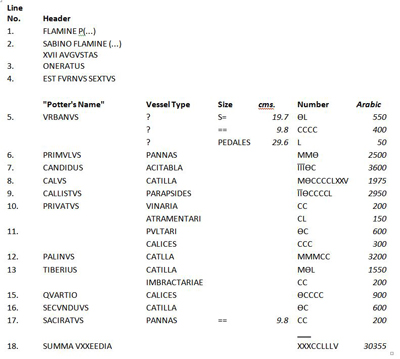
Marichal (1988, 85) follows Hilgers (1969, 135) in agreeing that this vessel is an analogue of the Greek κανούν, originally a wicker basket used for containing fruit. However, Hilgers notes that the Greek term can also refer to something made from solid material and that must be the case here. On the rather thin evidence of a single fragment, Marichal ascribes the vessel to Drag. 22 (Marichal 1988, Graffito 184). However, the discussion of the canistrum as an open flat basket often used for handing round bread is perhaps more apposite (White 1975, 62), and perhaps the canastri of the graffiti are rather larger vessels. Something like form Conspectus 19.3.2 would fit (Ettlinger et al. 1990), and its derivatives could then be the larger rouletted series of dishes at La Graufesenque, notated as 'R' forms (Amyx 1958, nos 24, 267).
Clearly these are mixing bowls, but not the gritted form for grinding, since that type was not made at La Graufesenque (e.g. forms Drag. 43 and Drag. 45, which belong to the second and third centuries). The essential quality here is the pouring-lip, which is associated with Ritt. 12. It is interesting that this shape disappears from the repertoire by c. 70 CE at the latest, and seems to be replaced with Curle 11, which does not have a lip. Athenaeus (VI, 231b), quoting Diphilus, describes a sauce served in silver mortari, which was presumably poured on the relevant dainties.
Two post-cocturam graffiti associate the panna with communal drinking (Marichal 1988, 88-9). They are inscribed on Drag. 37s, which are not usually stamped on the basal interior at La Graufesenque, but the Drag. 29 appears to have performed the same function before c. 70 CE. This dating is generally accepted for a pre-Flavian group from Cirencester, which does not have Drag. 37 (see Hartley and Dickinson 1982, 133-39). It contrasts with the group found in House VIII 5, 9, in Pompeii (Atkinson 1914), which has recently been reassessed (Dzwiza 2004), with an assembly date before 79 CE, and with the load from the Cala Culip shipwreck (Nieto and Puig 2001) where these two forms are found together. The dating evidence for the Cala Culip vessels is somewhere between 78-82 CE (Dickinson and Hartley 2001). The absence of any stamped form Drag. 29s recorded so far from Vindolanda, and the appearance of only form Drag. 37 in the Period 1 ditch deposit, dated there to the early 90s CE, are indicative (Birley 1994).
If this equivalence is correct, the series of Drag. 37s, principally made at Banassac, is relevant here. These particular vessels have moulded inscriptions of conviviality, often associated with images of vine-scrolls, and in one case a dedication to beer (Hoffmann 1988, plates 50-56). Whether the panna was actually handed round for communal drinking, or is the equivalent of a small mixing vessel is not clear (Bird 2008, 135). Some South Gaulish Drag. 37s have strap-handles and spouts, which disappeared from use by the second century at other production centres, but form Drag. 29 does not have these features, so perhaps there is a small difference in the use of the two shapes that developed over time. One identification problem is that of the small pannas recorded by Marichal (1988, 82) with the notation 'pannas==' (see also Figure 1), which have a likely diameter of 9.8cms. These can hardly have been mixing bowls, and are more likely to have been drinking vessels.
Opinion is not settled on this form, but if it is not a lagoena (jug or flagon) the complete omission of that type from the graffiti must be coincidental. Certainly there are small jugs shown in the drinking set from the tomb of Priscus (see above). The sigillata ones are sometimes signed, but not stamped, so they do not show up consistently in NoTS or the RGZM database for quantification and they seem to have been made by a restricted number of potters, principally Masclus i and Sabinus iii. Their purpose on the Roman table is not clear, the origin apparently being in personal wine jugs brought by guests (Athenaeus, VI. 276b). The largest are known to have a height of c. 900 mm, that capacity being excessive even for a Gaulish wine buff (Hermet 1934, 8).
Here, Marichal (1988, 91) refers to 'casserole à bouiller' apparently following Apicius (Grocock and Grainger 2006, recipe 6.2.15). However, in sigillata terms this cannot be correct. The material does not respond well to point-of-flame contact, although it might well stand dispersed indirect heat. The root puls would suggest identification as a small bowl, like the post-medieval handle-less porringer. Puls formed part of the staple diet (Cato LXXVI).) There is also a reference to drinking vessels from Petronius (Hilgers 1969, 264).
The assertion that the scribes used the terms interchangeably must surely be right (Marichal 1988, 86). There is no problem with identifying them as dishes (there are virtually no examples of sigillata vessels without a wall, which could in modern English terminology be called a 'plate'). Moreover, we have a hint that the largest were used as servers, rather than side dishes, in the recipe for 'catilliornatus' (Dalby 2003, 101; Hilgers 1969, 142), which would almost certainly have been served in bulk to the table for diners to pick up as they wished.
| Marichal no. | Potter | Die | NoTs date | Comments |
|---|---|---|---|---|
| 46 | Calvus i | 5u | 65-90 | Marichal read this as Germanus i |
| 8 | Castus i | 2b | 40-70 | |
| 13 | Castus i | 2d | 40-70 | |
| 21, 25 | Castus i | 2e | 40-70 | |
| 16 | Castus i | 2g | 40-70 | |
| 5, 6, 9, 20, 23 | Castus i | 8a | 40-70 | |
| 17, 19 | Castus i | 17b | 40-70 | |
| 1, 3, 7, 10, 11, 19, 22 | Castus i | 17c | 40-70 | |
| 4 | Castus i | 17c' | 40-70 | |
| 12, 14 | Martius ii | 2a | 40-70? | |
| 24 | Albus i | 9a | 45-75 | |
| 27 | Modestus i | 21a | 40-65 | |
| 30 | Tertius ii | 2c' | 15-50 | |
| 34 | Pontus | 8d | 65-95 | |
| 46, 89 | Germanus i | 1a | 65-90 | |
| 54 | Rutaenus | Not accepted in NoTs | ||
| 74 | Senilis i | 2a | 50-85 | |
| 86 | Logirnus | 5a | 60-90? | |
| 110,169 | Cosius Rufinus | 4b | 70-90 | |
| Other graffiti | ||||
| Vernhet and Bémont 1990-1 | Rufus iii | ? | 65-95 | |
The case of the catilibol- is relevant here (Marichal 1988, 84). Far from being a dish on which to serve mushrooms as he suggests, it is associated in literature with a wide range of foods, and the term is more likely to have referred to its own shape than to the contents that were destined for it (Grocock and Grainger 2006, 334). There are also references to it being used to serve fish and cabbage (Hilgers 1969, 121). It is interesting that this vessel occurs on graffiti stamped by Calvus i, Germanus i and Logirnus, all potters whose careers went into the Flavian period (Table 2), but does not occur on any of the graffiti stamped by Castus i, or the other pre-Flavian potters (Marichal 1988, 273). This might be a coincidence, but raises the possibility that the catilibol- belong to the Drag. 35/6 series, which would certainly resemble mushrooms if stacked upside down in the kiln or on the shelf (Table 1).
Not identified, and seemingly a very small production, perhaps an idiosyncratic description.
This is a very problematic name, which occurs only on those graffiti that are described as being written in 'Gaulish' (Marichal 1988, 88). The statistics do not unequivocally support the assertion that it represents Drag. 33 (see below).
The paropsis has numerous textual references that are summarised as a side dish for sauces, vegetables and small food (Hilgers 1969, 238-9). Whether the origins of its name lay in the food it contained, or the vessel itself was the subject of debate in classical times (Athenaeus IX, 367b-368d). There are references to it being used for dipping food in brine-sauce (Atheneus VII, 292 and 303e), and for ham with mustard sauce served as a side-dish (Athenaeus IX.366a). There is a late reference quoting Eucherius, Bishop of Lyons from his Instructiones II - 'paropsis: acitabulum maius: aliqui et catinum ita appellari putant' (trans. 'the parapsis or large acitabulum is called by some people a catinum', Hilgers 1969, 239). It is clear that these vessels had multiple functions as small containers, and were substituted by others.
The Colloquia of the Hermeneumata Pseudodositheana have very relevant instructions for giving a dinner party (Dickey 2012, 117-25). A schoolboy is told among a list of actions how to mix wine, to mix sauces, to put sauce in an acetabulum, and dip into a pre-prepared pepper sauce. Elsewhere, there are the instructions relating to acetabulato 'put out fish sauce with vinegar' (oxygarum in one of its spellings, Grocock and Grainger 2006, 384), and also fish paste (allec). There is a recipe for pullum oxizonum (Grocock and Grainger 2006, 230) where a large acetabulum of oil, a small acetabulum of liquamen (fish sauce), and a very small acetabulum of vinegar are used. In a further reference to service at the table there is an instruction to 'bring honey in an acetabulum' (Dickey 2015, 100-1, with the footnote 18d at 134), where it suggested that the honey is brought and added to vinegar (acetabulum) on the table.
These references confirm the vessel as connected with vinegar and sauces, and indeed as a measure both of vinegar and oil in the kitchen, much as the use of the word 'cup' as a measure in modern American recipes. Cup sizes have been estimated and analysed (Dannell 1993, 23; Polak 2000, 65-137), and these show that they were made in standardised groups of sizes - which might be described as 'small', 'medium' and 'large'.
There is absolutely no problem here with the identification of this named type as an inkwell, so this is not a dining table item.
The forms in the modern type series developed by scholars, as noted above do not reconcile with the names of those vessels described on the graffiti. There are simply too many forms distinguished in the modern series, and to that extent, where two or more are contemporaneous, it can only be concluded that the vessel types on the graffiti are 'portmanteau' descriptions (Polak 2000, 73 and see Table 1). The La Graufesenque graffiti were inscribed on stamped dishes and it is clear that those recovered cover a date range from c. 50-95 CE (Table 2). During that time vessel shapes evolved, so that a description apposite to the earliest phase may not hold for the latest, which is not reflected in Marichal's numbers (1988, 250-58). Thus, in trying to analyse both quantitatively and qualitatively which vessel types may have appeared on the Roman table, there are major problems of both nomenclature and chronology. The evidence presented here also suggests that customers chose what was available at point-of-sale, rather than pre-ordering, since the Latin or Gaulish names in use could have applied to more than one form. Perhaps this is a fact to 'weigh in the balance' when considering whether the army was involved in 'contracting' for sigillata supplies, where an exact supply to match orders might be expected.
One matter that can be illuminated is that of the calyx. It is the only drinking vessel regularly referred to in classical texts (Hilgers 1969, 130-34; Dickey 2015, 100-1). The word is absent from the graffiti published by Marichal, but does appear on a later find from La Graufesenque on a list discovered in 1991 (Vernhet and Bémont 1990-1), stamped by Rufus iii, c. 65-95 CE (Figure 1). Calyx should refer to a cup with a stem, and Privatus records having made 300 of them (calices), Quartio some 900, but that is very odd, because such vessels are almost absent from excavated sites from the Flavian period. The only explanation that suggests itself is that the reference is to the Flavian Drag. 50 (Table 1). Whether it was actually a drinking vessel is interesting given its connections to the Drag. 35 series (Vernhet 1976).
Insofar as the dishes are concerned, it is not clear whether the various forms used in the first century had functional or decorative/aesthetic differences (Table 1). However, we have some clues from the texts above, from the morphology of sigillata and from graves. Observations (Cool 2006a, 195-96) on the grouping of the Grave 2 vessels at Grange Road, Winchester (Biddle 1967, 231, fig. 5), can be extended to point out that it is the unusually large Drag. 18 (no. 2) that is placed together with the serving tray (no. 1). Perhaps an 'R' form was not available. Complete associations are impossible to unravel. The two flagons, together with their three accompanying Drag. 27s, are very suggestive, but the other mixed group of flagons, dishes and Drag. 27s is more difficult to interpret.
Winchester also offers another insight into dining practice, where the assemblage of Flavian sigillata, from a supposed burial(s?) at Milland, has no forms Drag. 18, Drag. 24 or Drag. 27, but 5 x Drag. 15/17, 4 x Drag. 33, 4 x Drag. 35 and a Drag. 36. It would seem that the functionality of Drag. 15/17 and Drag. 18 have been exchanged, as with Drag. 33 and Drag. 27, while the new service of Drag. 35/6 seems to be taking the place of Drag. 24, and perhaps that of Drag 18R (Dannell and Hartley 1978).
The form Ritt. 1, which is essentially a flat dish with a low wall, goes out of fashion by the early Neronian period. There are only two stamped examples recorded from Britain. There is apparently no successor for the shape in the repertoire until the Antonine period, when forms Walters 79 and 80 appear, suggesting that flat-bottomed dishes had a menu-related function.
There is then the case of Drag. 18. This is the most common dish of the first century, but as can be seen (Table 1), it changes its shape throughout that period, and then develops further, the central 'boss' getting higher and the wall deepening (as Drag. 18/31 and Drag. 31). The result would be to throw food towards the edge of the dish, and this suggests a preference for more liquid recipes like soups, and loose stews as time went on, making it easier to use a spoon, or indeed bread to lift the gravy, but difficult to use a knife.
That this feature of the development of Drag. 18 to Drag. 31 is accompanied by a rise in the popularity of Drag. 38 (replacing form Curle 11), and other heavy bowls with external flanges, which offer a good grip when being lifted, reinforces this hypothesis (Table 1). Whether the later sigillata gritted mortaria were actually carried to the table is a moot point.
The graffiti, when complete, account for c.30,000 vessels but many graffiti are broken and thus have fewer vessels and less vessel names represented. One problem with the series published by Marichal (1988), is that it is dominated by complete graffiti stamped by Castus i, which form c. 85% of all vessels noted by Marichal (1988) (Datasheet 1 - XLSX). This poses a problem of whether the repertoire of vessels on them is representative over time, taking into account the dates of all of the stamps known from all of the graffiti (Table 2).

To test the consistency over time, a comparison has been made of the data from all of the graffiti recorded by Marichal (1988) to those of the most complete (as recorded in Datasheet 1 - XLSX). While they do not correspond exactly, the orders of magnitude are sufficient to show that the total series is fairly consonant (Table 3 and Figure 2).
| Vessel name on graffiti | Quantity (column 2) | % | Quantity (column 4) | % | Stamped/Signed |
|---|---|---|---|---|---|
| Canastri | 8395 | 1.09 | 6275 | 1.79 | S |
| Mortari | 16103 | 2.08 | 6273 | 1.77 | |
| Pannas | 42424 | 5.48 | 13375 | 3.38 | S |
| Vinari | 4415 | 0.57 | 1515 | 0.43 | |
| Pultari | 2450 | 0.32 | 700 | 0.20 | |
| Catili | 199848 | 25.83 | 77665 | 21.97 | S |
| Inbratari | 0.00 | 165 | 0.05 | ||
| Licuias | 111694 | 14.44 | 65000 | 18.39 | S |
| Paraxidi | 170250 | 22.00 | 67960 | 19.22 | S |
| Acitabli | 212450 | 27.46 | 113550 | 32.12 | S |
| Atramatari | 1505 | 0.19 | 1030 | 0.29 | |
| Catinos | 4175 | 0.54 | S | ||
| Totals | 773709 | 100.00 | 353478 | 100.00 |

These data can be used to compare with what can be extracted from the RGZM database. All data used here were taken between 20 and 22 November 2016 by using 'Search' to generate Excel Sheets, which were then edited to leave only verified stamps. The stamped vessels have been summarised into general categories of cups, dishes, and decorated bowls etc., without any implication that these modern terms reflect or describe their original use (see Table 1 and Datasheet 2 - XLSX). However, note the remarks above about the inequality in the stamping of Drag. 29 and Drag. 37, on the assumption they were used for the same purposes. Figure 3 shows the relative proportions of the potters' own descriptions of vessels, from Marichal (1988). This is compared (in Figure 4) with the relative proportions of categories of assumed modern shapes. This results in a huge preponderance of cups over all other shapes.
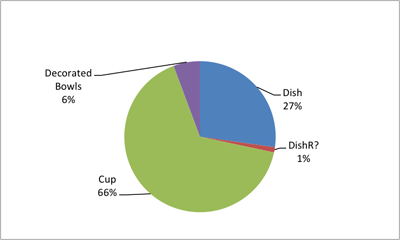
The next step is to look at the data derived from the RGZM database, this time using the form series and the same assumptions of modern shape. Three situations are represented: 1) all stamped vessels recorded in graffiti as made at La Graufesenque, 2) all actual stamped vessels found at the La Graufesenque kiln site and 3) all stamped La Graufesenque vessels found at other sites to which they had been exported (i.e. 'net exports' or the total number of vessels exported from La Graufesenque found on consumption sites). Two versions of the results are offered, based upon the view taken of Drag. 24 (see Dannell 2006, 161) as to whether it was indeed a drinking vessel (= cup), or a small bowl used for sauces. The data are set out in Datasheet 3 (XLSX) and summarised in graphic form in Figures 5a, 5b and 5c (where Drag. 24 = cup) and Figures 6a, 6b and 6c (where Drag. 24 = small bowl or dish).
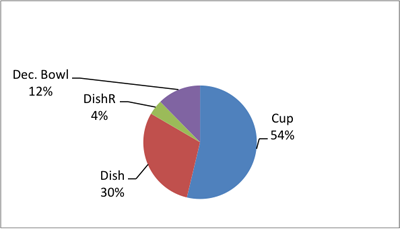
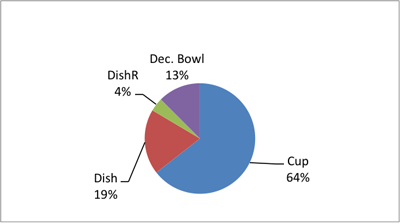
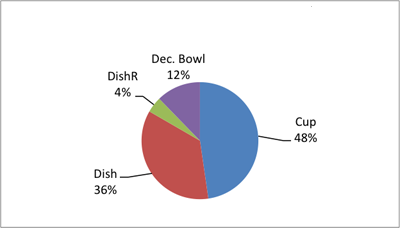
Figures 5a-c and 6a-c all show that the vessels attributed as rouletted dishes ('R'), which are generally larger than most other dishes and have a 'square' profile 'footring' (Table 1), and the decorated bowls have fairly constant representations at c. 4% and 12% respectively. The biggest difference is seen between the percentages of the cups and dishes, when comparing those vessels found on the kiln site (cups = 64% or 46%, dishes 19%, depending on classification of Drag. 24), and what has been recorded from export destinations (cups = 48% or 40%; dishes 36%). An obvious suggestion for this difference is that losses of cups in the kiln were rather greater than for the sturdier dishes. Piles of deformed cups are common at La Graufesenque (Vernhet 1991, 37).
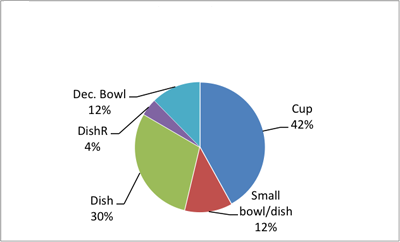
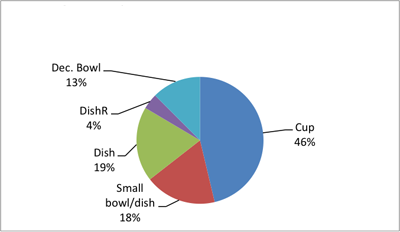
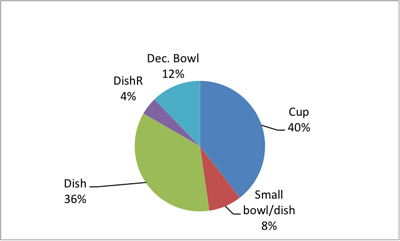
The paraxidi are a problem, given that they ought to be small bowls or dishes (see above), and if the Drag. 24 etc., are counted as such the numbers begin to make more sense in terms of potential place-settings where an approximate ratio of one cup to one dish might be expected, with the overwhelming proportion of cups being reduced, and the ratio of cups to dishes beginning to be closer to that found on export sites (Figure 6a-c). This suggests that Drag. 24 etc. might not be cups, but perhaps to be regarded as a small bowls or dishes and indeed saucières.
| Forms | All RGZM Db % | LG RGZM DB 5 | Net export RGZM Db % |
|---|---|---|---|
| Drag. 27 | 58.57 | 31.49 | 67.41 |
| Drag. 24 | 23.29 | 52.99 | 17.61 |
| Drag. 33 | 9.96 | 9.54 | 7.17 |
| Ritt. 8 | 5.31 | 4.31 | 4.62 |
| Unspecified cup | 2.87 | 1.67 | 3.18 |
| Total | 100.00 | 100.00 | 100.00 |
What remains unsolved is how the shape names acitabili, paraxidi and licuias can be shared among the form series. The 27 (comprising all variations of the basic form) is quantitatively the most popular cup by far on all export sites (Table 4 and Figure 7), with well over double the quantity of Drag. 24 etc. The room for re-allocation is limited as the licuias remain problematical. They represent c. 14% of vessels on the Graffiti (Table 3) but Drag. 33 is only 7-9% of the stamped forms found at La Graufesenque or on export sites (Table 4 and Figure 7) so there is no certainty of an equivalence of Drag. 33 as a licuias, unless the Ritt. 8 makes up the shortfall in some way, but the difference in shape makes this unlikely (Table 1).
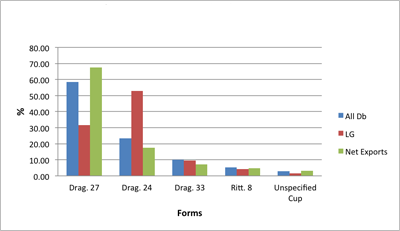
Comparisons between sites in different provinces and sites within provinces show interesting variations in classes of vessels appearing at different periods. If the shape of vessels is the criterion, then for all sites except Cala Culip, York and Caerleon, cups exceed dishes (Figure 8a). What is interesting about this is that those sites have larger Flavian components, so perhaps this was a developing trend. One possible suggestion is that the gradual change in the composition of the army from one based upon recruits from 'classical' provinces to embrace those from the northern provinces over time led to a change in emphasis away from wine and smaller drinking vessels.
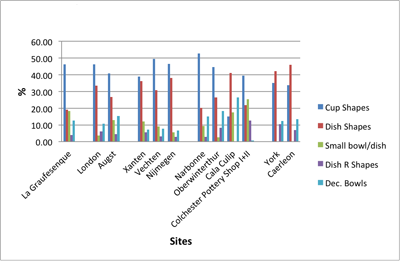
On the other hand, when form is the criterion there are much larger variations. Some are caused by date: the Ritt. 5 went out of production by the early Claudian period. However, there are significant variations in what ought to be similar sites: London and Augst; the Rhineland sites (Xanten, Vechten and Nijmegen); and the idiosyncrasies of the other shipwrecks and destruction deposits. It is possible that these variations were caused by supply, but more probably reflect true consumer choice related to the relevant food regimes. The occupation sites show much greater diversity of form. Two of the largest collections come from Augst and London. Augst shows far more Drag. 24s than Drag. 27s and this might be explained by the later starting date for the London sigillata (c. 50 CE; Dunwoodie et al. 2015, 11). Similarly, Xanten shows a greater proportion of Drag. 24 etc. compared to Vechten or Nijmegen.
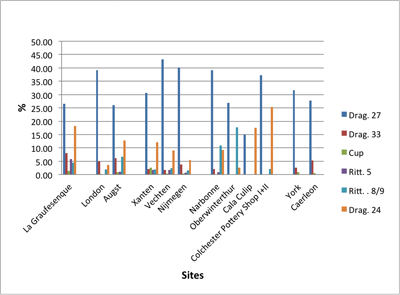
The remarkable quantity of Drag. 24s from the Cala Culip shipwreck (c. 78-82 CE, see above), contrasts with their total absence from York (c. 71+ CE; Monaghan 1997, 833) and Caerleon (c. 71+ CE; Webster 2013, fig. 14.10). The Cala Culip assemblage could represent prolongation of classical eating somewhere in the Mediterranean area, although where the ship was heading is unknown. The evidence for what happened in between is somewhat equivocal. The destruction of the Oberwinterthur Keramiklager, which is dated to around the time of the Batavian revolt (c. 69-70 CE; Ebnöther and Eschenlohr 1985) has few Drag. 24s, but the Colchester 'Pottery-Shops' destroyed c. 60-61 CE (Hull 1958) appear well stocked with the form (Figure 8b).
Clearly this depends principally on where the table was, when the table was set, and for whom. However, the staple food and drink must have had an over-riding influence. Drinking demanded cups, and although the acetabulum started off as a kitchen measure, it remains the only candidate to be quantified as the common table cup for wine and form Drag. 27 must be its equivalent (Dannell 2006). However, the Vindolanda list (Bowman 1994; Tab. Vindol. II 194), referred to above, shows acetabuli and calices separately. If this list belongs to an officer, perhaps the old distinctions prevailed.
Most tables would have had a mixing-bowl for wine, and the pannas have a good claim for this function. Vinari (= lagoenae?) were less common, and may have served as personal wine flasks, or for diluting wine to taste (Athenaeus XI, 499c-e). Next, food was served en masse and either picked up directly out of serving dishes, or cut up to be taken from smaller dishes given to individual diners, and the catili of Drag. 15/17 and 18 would fit that requirement. Sauces were commonly used for dipping and the suggestion here is for the paraxidi, probably Drag. 24, as side-dishes and, where larger quantities of sauce were required, the mortari (Ritt.12 and Curle 11). The ratio of cups to dishes found on sites is usually >1:1; this may reflect a rather higher breakage rate for cups in use, rather than a fixed imbalance on the table.
So, we might see a formal cena using sigillata, with a personal cup and dish setting, together with small bowls or dishes for sauces and/or dainties, and bowl(s) on the table for mixing wine. More rarely there would be flagons and un-gritted mortaria for pouring larger quantities of sauces. However, context is everything: what and how sigillata was used within the formal dining of a large town-house, by a villa owner, in the commandant's house of a fort or fortress, or in mess halls, almost certainly differed from its use in lesser circumstances, where the odd vessel or two might have been the prized possession of the paterfamilias. A useful summary (Birley 2002, 128-35), shows the range of dinner parties at Vindolanda. The number of ceremonial and religious festivities that necessitated formal entertaining and celebration can be underestimated when compared with modern custom (perhaps now just Christmas, New Year and Easter?).
One final more happy thought is that there is a persistent representation of very small vessels in most shapes (cf. Monteil 2005, figs 29-30, for forms Drag. 24/5 and Drag. 27, and figs 34-5, for forms Drag. 15/17 and Drag. 18). Is it possible that children had their own settings?
The limitations of only considering stamped vessels must be rectified by looking at complete collections of all forms. The stamps should be used with care, and other quantitative measures such as MNV or EVE used as a check in evaluating assemblages (Monteil 2005).
The study of wear patterns on sigillata vessels needs refining (Biddulph 2008). They are an interesting phenomenon, but may be less significant than supposed from their recognition. Biddulph (pers. comm.) estimates <5% of cups show wear. It is interesting that dishes do not show cut-marks - perhaps experiments using soft iron knives need to be carried out to see their effect.
Then there is residue analysis: sigillata does not easily retain residues, but its fine-ware copies, found widely where the real thing was either unavailable or too costly, for instance at Winchester, where Grave 1 has only imitations (Biddle 1967), should repay study. Examination of these imitations might just help to unravel the contents appropriate to different forms.
Internet Archaeology is an open access journal based in the Department of Archaeology, University of York. Except where otherwise noted, content from this work may be used under the terms of the Creative Commons Attribution 3.0 (CC BY) Unported licence, which permits unrestricted use, distribution, and reproduction in any medium, provided that attribution to the author(s), the title of the work, the Internet Archaeology journal and the relevant URL/DOI are given.
Terms and Conditions | Legal Statements | Privacy Policy | Cookies Policy | Citing Internet Archaeology
Internet Archaeology content is preserved for the long term with the Archaeology Data Service. Help sustain and support open access publication by donating to our Open Access Archaeology Fund.